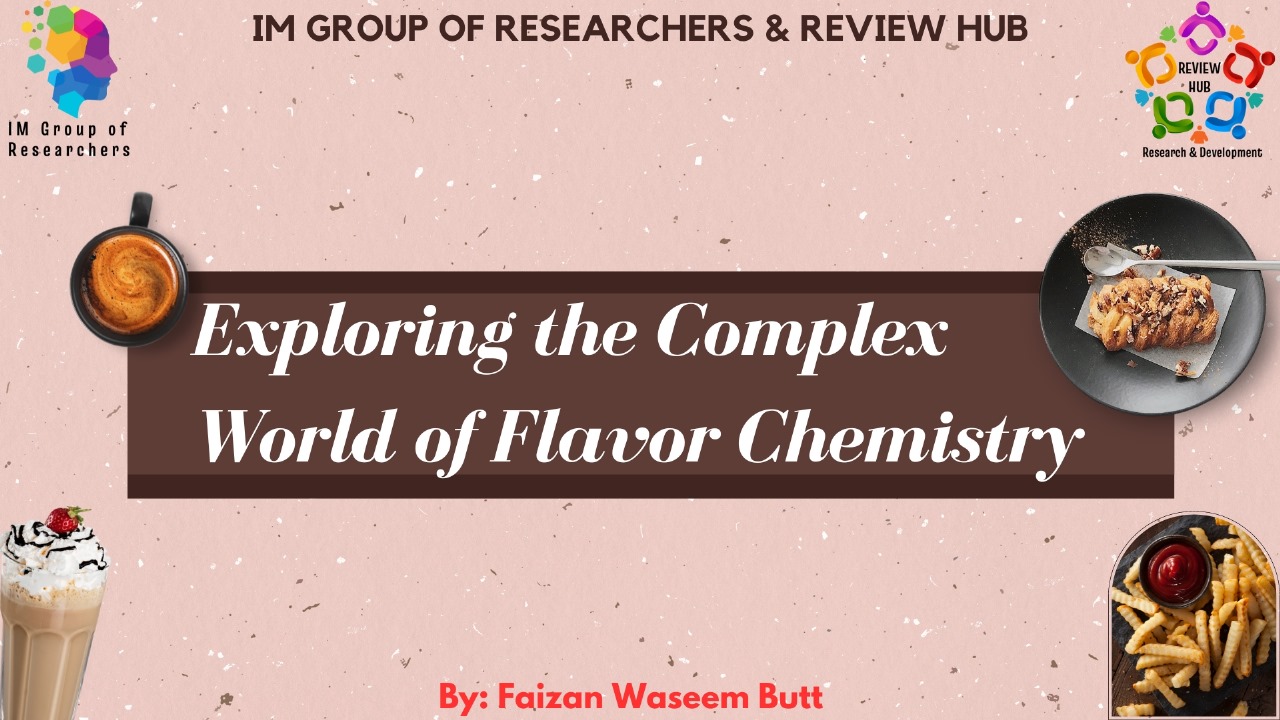Exploring the Complex World of Flavor Chemistry. In this article, we will embark on a journey through the world of flavor chemistry, exploring the science behind the sensations that tantalize our taste buds.
Author:
Faizan Waseem Butt

Introduction
Flavor is a multisensory experience that can evoke memories, emotions, and cravings. Whether you’re savoring a perfectly ripe peach, enjoying a hearty bowl of tomato soup, or indulging in your favorite dessert, the intricate dance of molecules in your mouth is responsible for the rich tapestry of tastes and aromas you perceive. Flavor chemistry, a fascinating branch of chemistry, delves deep into the molecular intricacies that underlie the taste and aroma of the foods and beverages we love.
I. The Five Basic Tastes
Flavor perception begins with the detection of the five basic tastes, each of which corresponds to specific chemical compounds and receptors in our taste buds:
Sweetness
The perception of sweetness is triggered by sugars and other compounds with similar chemical structures. When sugars like sucrose, glucose, and fructose bind to sweet receptors on taste buds, they signal the brain to register a pleasurable sensation.
Sourness
Sourness results from the presence of acidic compounds, primarily hydrogen ions (H+). These ions, usually found in substances like citric acid (found in lemons) or acetic acid (found in vinegar), stimulate our sour receptors.
Saltiness
Saltiness is the taste of sodium ions (Na+). Sodium chloride (table salt) is the most common source of this taste. Salt receptors detect the presence of sodium ions and send signals to the brain, creating the perception of saltiness.
Bitterness
Bitterness is a complex taste often associated with toxic compounds. Bitter receptors are sensitive to a wide range of bitter substances, such as caffeine (found in coffee), quinine (found in tonic water), and various alkaloids. Bitterness serves as a natural warning sign against ingesting potentially harmful substances.
Umami
Umami is a savory and meaty taste that results from the detection of the amino acid glutamate. Foods rich in umami compounds include tomatoes, Parmesan cheese, and soy sauce. Umami enhances the overall flavor of a dish and adds depth to the taste experience
II. Aromas: The Key to Flavor Complexity
While the five basic tastes lay the foundation for flavor, it’s the complex world of aromas that truly distinguishes one dish or beverage from another. Aromas are created by volatile compounds that are released into the air as we chew and swallow. These compounds are detected by our olfactory system, composed of the nose and the olfactory bulb in the brain. Thousands of volatile organic compounds contribute to the vast array of aromas we encounter, and they play a pivotal role in the overall flavor experience.
Terpenes
Found in many fruits and herbs, terpenes are responsible for a wide range of aromas. Limonene, for example, gives citrus fruits their characteristic scent, while myrcene contributes to the aroma of hops in beer.
Aldehydes and Ketones
Compounds like vanillin and cinnamaldehyde give rise to the familiar scents of vanilla and cinnamon, respectively.
Esters
Esters are behind the fruity aromas in many foods. Ethyl butyrate, for instance, is responsible for the sweet, fruity scent of pineapples.
Thiols
Thiols can have strong, pungent aromas. Methanethiol, for example, gives garlic its potent smell, while 2-furfurylthiol is responsible for the roasted aroma in coffee.
Pyrazines
Pyrazines are responsible for the nutty and roasted aromas in foods. They are found in roasted nuts and coffee.Alcohols and Phenols: Compounds like benzyl alcohol contribute to the pleasant, floral aromas of jasmine and other flowers, while eugenol provides the clove-like scent of cloves.
III. The Maillard Reaction: Flavor’s Culinary Alchemy
The Maillard reaction is a crucial process in flavor development, especially in cooking. It occurs when amino acids (from proteins) and reducing sugars interact at elevated temperatures. This reaction is responsible for the browning of foods and the development of complex, roasted, and savory flavors.
In essence, the Maillard reaction is responsible for the rich flavors of seared steak, toasted bread, and roasted coffee beans. Its products are a complex mixture of compounds that contribute to the delicious flavors and aromas we associate with these foods.
IV. Sensory Evaluation and Flavor Analysis
Analysing flavor is a multi-faceted endeavor, and various techniques and methods are employed to assess and understand the chemistry of flavors. Sensory evaluation, instrumental analysis, and chemical profiling are key components of flavor analysis.
Sensory Evaluation
Sensory panels, comprised of trained individuals, evaluate the flavors of foods and beverages using their senses of taste and smell. This method provides valuable information about consumer preferences and helps food scientists optimize product formulations.
Instrumental Analysis
Instrumental methods, such as gas chromatography-mass spectrometry (GC-MS) and nuclear magnetic resonance (NMR) spectroscopy, are used to identify and quantify the volatile compounds responsible for specific aromas and tastes.
Chemical Profiling
Chemical profiling involves the analysis of the chemical composition of food and beverages. This includes the identification of key flavor compounds and their concentrations, which can be used to recreate or enhance specific flavors.
V. Flavor Modulation and Enhancement
Flavor modulation and enhancement are essential tools in the food and beverage industry. These techniques are employed to improve existing products, mask undesirable flavors, or create entirely new taste experiences.
Flavor Enhancers
Compounds like monosodium glutamate (MSG) are used to enhance umami flavors in foods. They intensify the overall taste experience.
Masking Agents
Sometimes, certain undesirable flavors, such as bitterness or metallic notes, need to be masked. Masking agents are used to cover up these unwanted tastes, making the product more palatable.
Flavor Encapsulation
Flavor encapsulation involves enclosing volatile compounds in a protective matrix to prevent their premature release. This technique is often used in the production of flavored confectionery, beverages, and snacks.
VI. Natural vs. Artificial Flavors
The distinction between natural and artificial flavors can be a topic of debate. Natural flavors are derived from plant or animal sources, while artificial flavors are synthesized chemically. However, both can undergo significant processing and refining. Regulatory bodies like the Food and Drug Administration (FDA) closely monitor the use of flavoring substances to ensure safety.
Natural flavors are often preferred by consumers who are seeking “clean label” products with minimal processing. However, artificial flavors can offer cost-effective solutions for achieving specific taste profiles and can sometimes be more stable.
Conclusion
Flavor chemistry is a captivating journey into the world of taste and aroma. It reveals the intricate dance of molecules that creates the rich tapestry of flavors we experience in the foods and beverages we love. From the five basic tastes to the complex aromas that tantalize our olfactory senses, the chemistry of flavor is a multifaceted science that continues to evolve and amaze.
Understanding flavor chemistry not only enhances our appreciation of culinary creations but also plays a pivotal role in food and beverage development, quality control, and consumer satisfaction. Whether it’s the discovery of new flavor compounds, the fine-tuning of existing tastes, or the creation of entirely novel flavor experiences, the world of flavor chemistry is a tantalizing realm that continues to push the boundaries of our gustatory senses.
Also read: Smoking and Chemical Toxicology: A Comprehensive Exploration
Follow Us on

